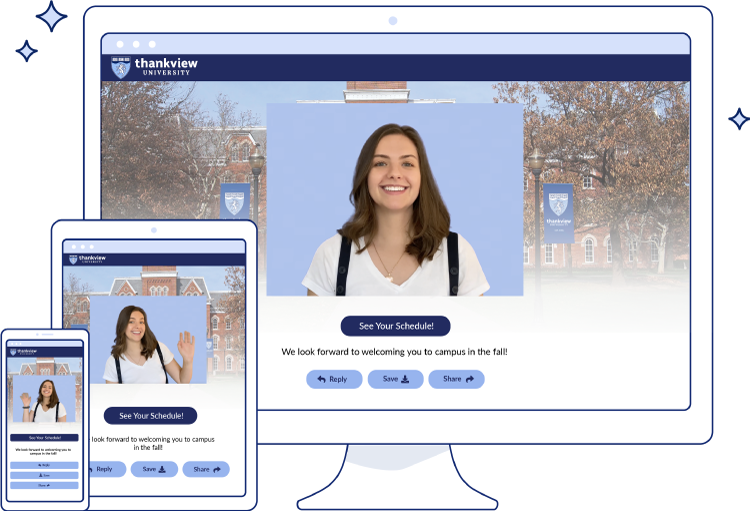Top Tips for an Effective Nonprofit Donation Page
Fundraising can be challenging for nonprofit organizations. While face-to-face asks have their charm and direct mail appeals are a proven approach, online fundraising is the way of the future. Creating a stellar donation page can help you bring in the big bucks while you sleep or oversee other important parts of running your organization. Digital fundraising is also a way to reach donors at scale beyond any geographical confines.
We’ll guide you on how to embrace the best technology and build a donation page that works.
Donation Page Best Practices
Your fundraising strategy should be well-rounded. Conversations, community events, and ads all culminate in the give. When potential donors land on your giving page, make sure they “convert” (follow through with their donation).
By now, almost everyone is accustomed to making purchases online, so as long as your systems and online donation form function well, collecting money via a nonprofit donation page should be a breeze.
General Tips
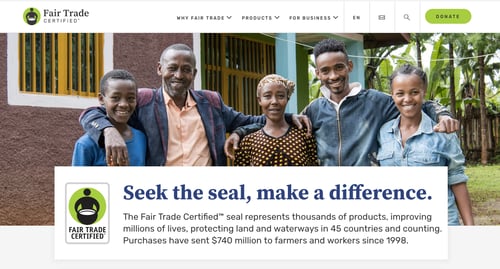
Make the path to your donate page prominent in your website’s menu, footer, and maybe even sidebars so that it’s visible from all pages. The button should stand out — preferably in a bright (branded) color. If visitors like what they see at any point on your website, you want them to be able to give with the click of a button.
The same goes for bringing in donors from social media. Facebook allows nonprofits to change their call to action button to “Donate.” On other platforms, make sure any next steps link directly to the online donation page.
Once they’re on your landing page, place the most important information at a visible spot at the top of the page before any scrolling is required. Also, include donate buttons throughout the page’s content.
You also want to remove barriers to make donating fast and easy. The page becomes more user-friendly if you streamline the process. That means requiring as few clicks and as little donor information as possible on your donation form. It’s equal parts capitalizing on convenience and capturing people’s impulses.
Consider listing suggested donation amounts to guide donors. Choose an approach that suits your donors, fundraising needs, and brand:
- Anchor their gifts with a tangible outcome whenever possible — this will likely boost your conversion rates. For example, “$25 feeds a family of four for one week.”
- Provide tiered giving options that allow donors to be part of an in-group or receive certain rewards in return. For example, donors who give $1,000 or more earn a premium membership to the museum, including guest passes and preferred parking.
- The ability to set up recurring gifts is a major advantage of an online donation form. Be sure monthly recurring donations are an option on your page. Convincing a donor to give $10 per month will net your nonprofit $120 over the course of a year. This is ideal for donors who wouldn’t consider giving $100 or more via a single donation.
The Marketing Side
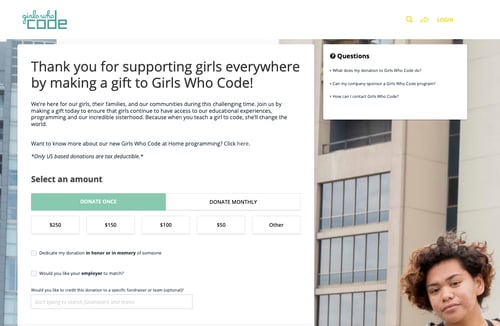
Stay on brand from start to finish during the donation process. Display your logo prominently. Your fonts, color scheme, and word choice should be consistent across all communications. Branded donation pages are no exception. That trust and recognizable branding is what got the potential donor to this page, and that’s what will keep them there as they make a donation.
As with traditional fundraising, make your donation appeal compelling. That means you should tell a story, show impact, and conjure emotions. You can either be super direct, or go with a choose-your-own-adventure page design, which would allow visitors to select content about the programs or impact stories that matter most to them. Consider including videos, audio, images, and interactive tools.
Make donors feel at ease. Provide social proof via testimonials from real donors who share why they choose to give. (This is especially important during peer fundraising campaigns where a supporter led the potential donor to the donation page.) Also answer FAQs on the page. This both reassures the donor and saves your staff precious time from answering repetitive questions.
Include share buttons that encourage donors to spread the word about their gift via social media. Positive peer pressure can go far in advancing your brand awareness, support for your cause, and base of donors!
The Tech Side

User experience is key to any website, but especially fundraising pages. Formatting errors are often most apparent on mobile devices. Take the time to ensure that your fundraising page (and your entire website) is mobile friendly.
Leverage matches when possible. This might be a standard option on your main donation page, or you could create a custom page for a specific matching gift fundraiser. The trick here is to have the mechanisms in place for donors to claim the match and the matching donor to receive the requests. A template from a third party provider can be useful in cases like this.
Provide payment options that are customizable to each donor’s preferences. This often includes debit/credit card, ACH direct deposit, and PayPal or Stripe. Depending on your page setup, the various payment methods might autopopulate, require a checkbox, or provide a dropdown menu. While you’re at it, ask your donor if they’d like to shoulder the payment processor fees!
When you collect donations online, you want to integrate the data with a CRM so that you can acknowledge the donor properly and build relationships with them moving forward. Each donation should trigger an automated email that sends a tax receipt. Also be sure to thank each donor via a confirmation page. Take this page one step further and direct the donor to past content you’ve created. Maybe it’s a top-ranking blog post or a link to your most popular social media profile. Maybe you embed a video that shows the impact their donation could already be having.
And of course, keep donor data safe. If your site has not already been secured and doesn’t show “https” at the beginning of your URL, this should be your top priority before collecting donations.
Powerful Donation Page Examples
United Way of McLean County uses an innovative tool to provide an interactive experience to donors. When donors visit this page, they watch an intro video, which leads them to a page where they can click to watch additional clips based on the community issues they care about. From there, they can watch even more impact stories, or they can continue on to the donate page.
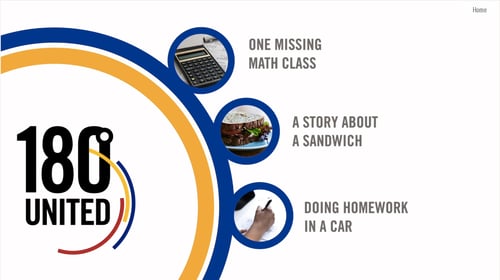
Sierra Club strategically provides not one, but three giving buttons “above the fold” (near the top before you have to scroll) on their homepage. They pair these with strong imagery and language that incite people to take action.
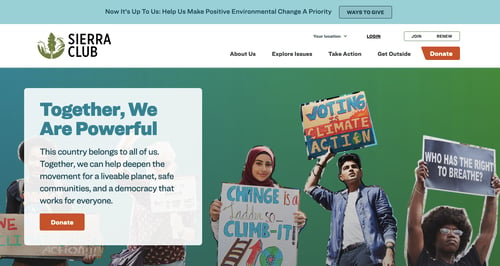
IJM implements variety on their donation buttons. They use the standard “Give Now” in their header, but they also use a brand-specific call to action with “Send Rescue.” They also highlight a current match campaign on their homepage.
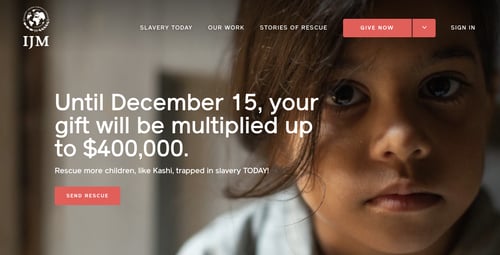
Alley Theatre leveraged video and storytelling to raise awareness about destruction caused by a local hurricane as quickly as possible. They used video again to personally thank their donors.
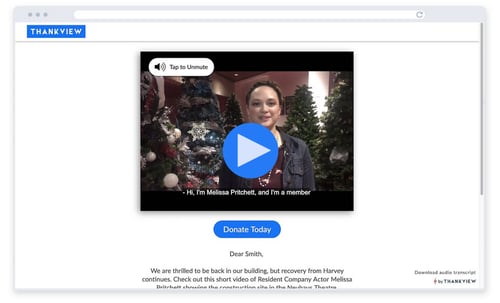
Putting Donors First
The donor experience makes or breaks your fundraising campaigns. That’s why building a powerful donation page is so important for modern philanthropy. It can attract new donors and increase retention with existing supporters.
Step up the giving experience with custom videos. The ThankView video platform makes it easy to engage your audience, whether to encourage donations or as a way of following up after someone gives. Sign up for a demo to see how to include the power of video on your own donation pages.
